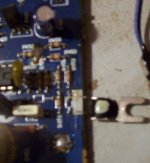I appologize for knowing little or nothing about electronics, please be gentle when explaining things to me
I took the amp apart and found that the lead going from the part to the circut board had broken where it conects to the part. The part is attached to the heat sink (ground) via a screw.
The amp will burp contiunously and go into protection mode, non of the transistors around this part are messed up so I assume this to be the culprit.
If anyone could tell me what it is and where to get it, I would greatly appreciate the help.
Thanks
TJ

I took the amp apart and found that the lead going from the part to the circut board had broken where it conects to the part. The part is attached to the heat sink (ground) via a screw.
The amp will burp contiunously and go into protection mode, non of the transistors around this part are messed up so I assume this to be the culprit.
If anyone could tell me what it is and where to get it, I would greatly appreciate the help.
Thanks
TJ
Attachments
I was trying to get a reading on the thermister to see what its resistance at room temp would be, and I couldn't get a reading.
2.7K ohm to 3.9K ohm, is that a typical range for thermisters or is that the range that this specific one.
If I used a resistor instead of a thermister, then I would have basically no thermal protection? I don't think it would be a big deal, I only run a 4 ohm load anyway.
2.7K ohm to 3.9K ohm, is that a typical range for thermisters or is that the range that this specific one.
If I used a resistor instead of a thermister, then I would have basically no thermal protection? I don't think it would be a big deal, I only run a 4 ohm load anyway.
Typically, an amp will work fine with a missing thermistor. The resistance goes up as the temperature goes down so an open thermistor tells the protection circuit that the amp is cold (really cold). Unless the manufacturer has low temp thermal protection, the amp should work with a missing/broken/open thermistor.
Where did the leads break (at the body of the thermistor or at the circuit board)?
Where did the leads break (at the body of the thermistor or at the circuit board)?
It sounds like you have other problems (possibly shorted output transistors). If the amp simply had thermal protection problems, it should not make a sound because the thermal protection circuit would likely never allow the power supply to switch on.
It sounds like the amp is trying to power up but senses either overcurrent or DC offset and is shutting down.
If you are careful, you can chip away the epoxy around the broken lead to expose enough of the lead wire to solder an extension on it. Use a pair of sharp flush cutting pliers. Use a very small diameter wire as an extension. This will keep the stress on the solder joint at a minimum.
It sounds like the amp is trying to power up but senses either overcurrent or DC offset and is shutting down.
If you are careful, you can chip away the epoxy around the broken lead to expose enough of the lead wire to solder an extension on it. Use a pair of sharp flush cutting pliers. Use a very small diameter wire as an extension. This will keep the stress on the solder joint at a minimum.
- Status
- This old topic is closed. If you want to reopen this topic, contact a moderator using the "Report Post" button.
- Home
- General Interest
- Car Audio
- Help identifying a part in a hifonics centurion amp
